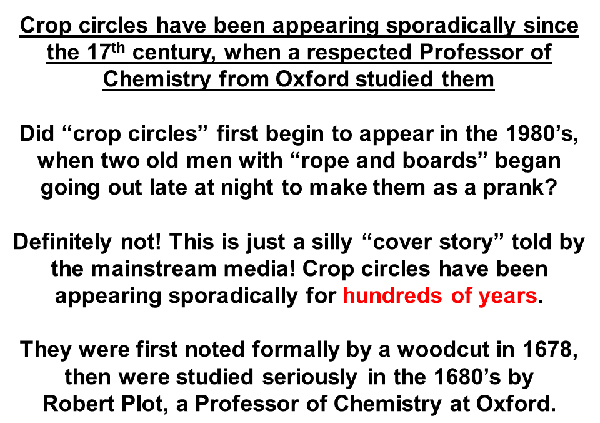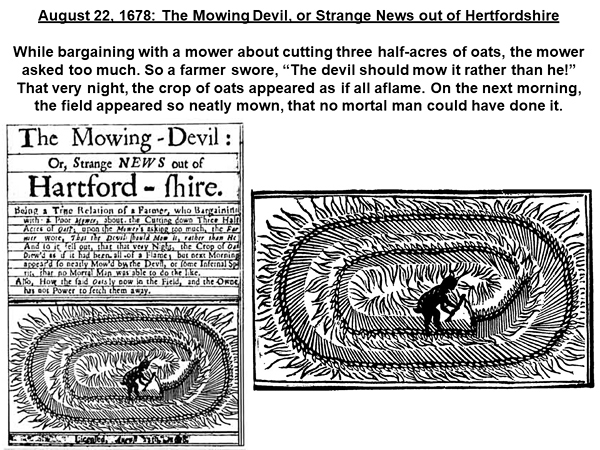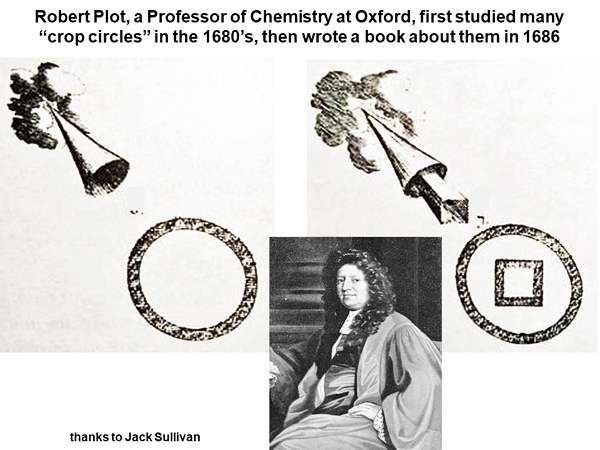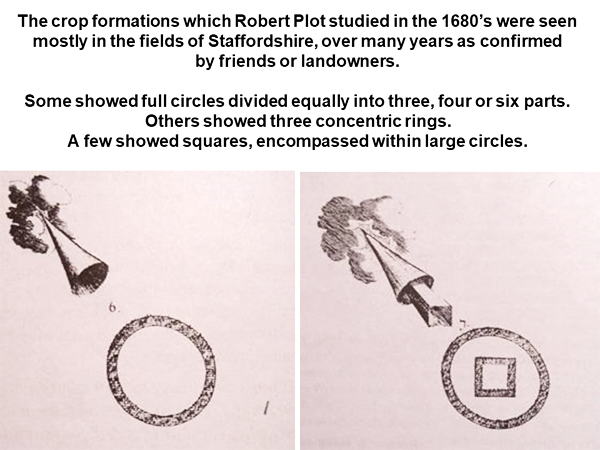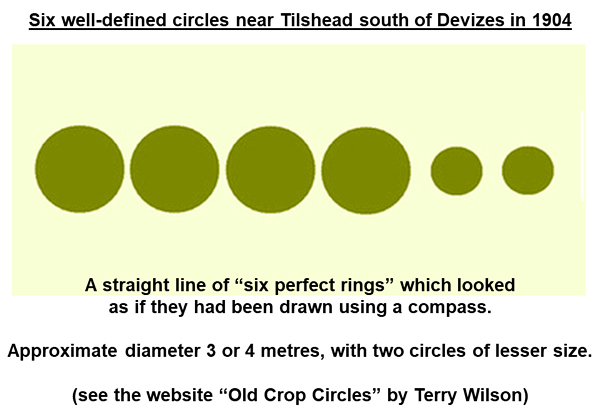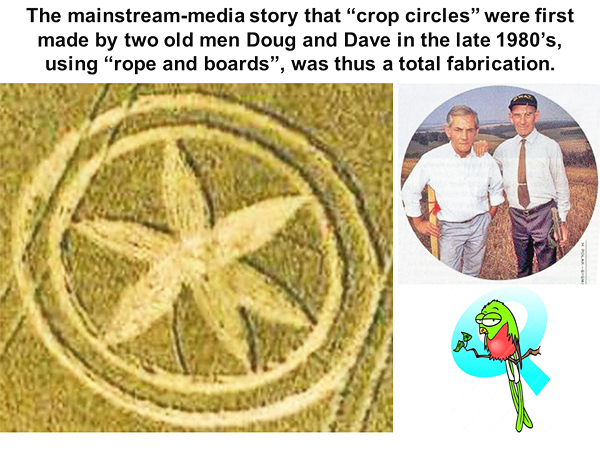|
“Crop circles” have been appearing sporadically since the 17th century: they were not “first seen” in the 1980’s, when supposedly “two old men left the pub late at night with rope and boards” Any scientific hypothesis to explain the strange and unexpected appearance of “crop circles” would have to explain why some crop circles (of moderately complex shape) have been appearing sporadically in England or other countries since at least the 17th century. Please see below a series of summary slides from one of my talks, which give a brief overview of “historical crop circles”. For more detailed information, please see some excellent articles or compilations by Jack Sullivan or Terry Wilson (see time 2012xl or time 2012yl or oldcropcircles.weebly.com). Many historical crop circles, from an era before modern airplanes or trains, were perhaps never seen or documented. Others have recently been detected through the study of old aerial photographs, taken near the end of World War II (see aerial-photography). Finally when you read in some article from the mainstream media that “crop circles” were “first seen” in the 1980s; when supposedly “two old men left the pub late at night with rope an boards”, you can be sure now that the reporter does not know anything, or has decided not to tell the truth.
Science versus pseudo-science The widely-held theory of “rope and boards” is just another form of pseudo-science as defined by Karl Popper (see www.youtube.com). “Not all swans are white.” Nor have all crop circles been made, just in modern times since 1980, using rope and boards. We always have to be ready to revise our beliefs based on new evidence. The skeptics or debunkers are not open to the possibility that their current ideas might be false. Pseudo-science seeks to confirm what you already think, whereas real science seeks to disconfirm. It has nothing to do with whether some idea (say UFOs or crop circles) is “orthodox” or “widely accepted” in the scientific community. If you refuse ever to change your ideas, based on new evidence, then you are doing pseudo-science. A brief summary of “fairy ring” (or “crop circle”) research in the 1680’s, adapted to modern English from “The Natural History of Staffordshire” by Professor Robert Plot of Oxford I decided to condense and re-write part of Robert Plot’s long text in modern English, because no non-English speaker could possibly understand his original essay as it was written, and likewise Google Translate does not work well on “old English”. Please see Chapter 1 “Of the Heavens and Air” if you wish to struggle through his long, original and uncondensed text quod.lib.umich.edu . These particular “fairy rings” came down quickly from the sky, to produce “circles” in the grass (or crop) of diameter 40 or 50 yards, which often showed thin outer “rims” Many of the “fairy rings” from 1680, which Plot describes, could not be possibly be due to some kind of fungus, like for the precise meaning of that word today. There was a great deal of evidence at the time that they “came down quickly from the sky”, including reliable eyewitness accounts. Of course these learned Fellows or Professors from Oxford would not be interested in small, diffuse, dark rings on the ground, caused by a common fungus! Some of the historical “grass circles” which he describes were 40 or 50 yards in diameter. Also they typically had narrow outer “rims” which were just one foot to one yard wide. That sounds just like a description of many large but simple crop circles which we see today. Fungal fairy rings actually damage nearby plant growth, whereas the ones described by Plot have a “fertilizing quality”, just has been described by studying the improved growth of seeds taken from modern crop pictures. A theory of “circular lightning” He also describes the flattened grass (or crop) in his fairy rings as slightly “burnt and brittle”, which is another characteristic which we see sometimes in modern crop pictures. His theory was that they may have been made by unseen bursts of “circular lightning”, which have to pass through hypothetical round or square “holes” in the clouds far above. This was a reasonable theory for the time. Indeed “sheet lightning” was seen just before a famous July 7, 2007 crop picture appeared in East Field. How to explain three nested and concentric rings? In order to explain by his theory for example a triply-nested crop circle with three concentric rings, one inside another, Plot postulated that there might have been three successive bursts of circular lightning from a common yet unseen aerial source. Each burst might “widen slightly the hole in some cloud” by which they came down to the ground, thereby causing the first inner ring to be small, the second centre ring to be of medium size, and the third outer ring to be large. What else could he be describing except for a modern “crop circle”? Squaring the circle Plot also describes several examples of “fairy rings” which consisted of one large circle around the outside, with a quadrilateral of square nested within. What else could that mean except for some modern crop circles which show “squaring of the circle”? (see www.youtube.com or www.cropcirclesandmore.com ). And now let us read a brief summary of a strange phenomenon which various learned fellows of colleges, or professors from Oxford, were studying at the time of Sir Isaac Newton. “Here it may be of no great digression to enquire into the nature and causes of those ‘rings’ which we find in the grass sometimes, commonly called ‘fairy circles’. I saw a large example of that kind in the grounds between Handsworth Church and the Heath, which was nearly forty yards in diameter. I was also told by an ingenious gentleman, Sir Henry Gough Knight, that there had been one in his grounds near Pury Hall, a few years past, of even larger size, nearly fifty yards in diameter. Some however are no more than two yards in diameter. They differ not only in the sizes of their diameters, but also in other ways. For example the outer rims of these fairy circles, from the smallest to the largest, may be as narrow as a foot, or as broad as a yard. Some are circular in shape, while others are semicircular. Some show quadrants, while others show sextants. I decided to examine the nature of the soil under their outer rims, especially how it might differ from adjoining soil? Thus I found by digging, that the ground under all of them was looser and drier than normal. Next I wished to look for some cause? After long deliberation, I could think only of one possible cause, that they might be made by lightning, if it were to come down from the clouds with a circular shape. Not only single circles, but sometimes doubly or triply-nested circles may be found. Some of these were shown to me by a friend John Priaulx of University College, in the field between St. Giles's Church and a garden called Jericho. Other fairy circles have even shown a quadrangular (or square) shape, encompassed by a larger circle. Two examples of that kind were shown to me by John Naylor and Hugh Todd of University College in the same fields. All of these different shapes may perhaps be explained by a similar hypothesis: namely that a fairy circle with three nested rings, for example, could be caused by three successive flashes of lightning. A second flash might widen the hole in some cloud, more than the first flash. Then a third flash might widen that same hole, more than the second flash. Some flashes of lightning could even emerge from a cloud, first with a quadrangular (square) shape, and then with a broad circular shape. The soil underneath them becomes improved, though it may not show this ‘fertilized quality until later.” Red Collie (Dr. Horace R. Drew) |
